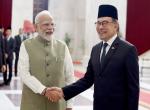Article 79 of the Constitution provides for a Parliament for the Union consisting of the President, House of the People (Lok Sabha) and the Council of States (Rajya Sabha). Our bicameral Parliament thus shapes itself on Westminster, where Parliament consists of the Sovereign, the House of Lords and the House of Commons in Parliament assembled. By contrast the U.S. Parliament, called the Congress, consists of the House of Representatives and the Senate, the latter representing the States, but does not include the President. There the separation of powers is total, whereas in India the Executive, the Legislature and the Judiciary overlap at the margin. One common factor between India and the U.S is that both have an Upper House which is supposed to represent the States, but in India the representation of the States is unequal because the number of seats allotted is based on the size of the State Legislature whereas in the U.S. Senate each State has two seats.
In Britain the Commons are the repository of real legislative power because the Lords can advise, suggest changes in a proposed Bill and slightly delay, but they cannot overrule the Commons. In the U.S. all Money Bills must originate in the House of Representatives, but both Houses have equal powers with regard to legislation and if either House decides to reject a Bill there can be a total stalemate. In India if a Money Bill is rejected or amended by the Rajya Sabha it goes back to the Lok Sabha, which can vote on the final shape of the Bill and that goes to the President for assent as if both Houses have passed it. However, for all other legislation either House can kill it through rejection and the present government is finding difficulties in pushing key legislation through the Rajya Sabha because it does not have a majority in that House and the Opposition has combined in frustrating government. Of course under Article 108 the President can summon Parliament to a joint sitting of both Houses where a stalemated Bill will be discussed and if the majority of Members present and voting pass the Bill, it will be deemed to have been passed by both Houses.
The problem with a joint sitting is that our system is based on the collective wisdom of our Parliament considering and debating a Bill on merits, aimed at promoting the welfare of the people and not on narrow, sectarian, partisan or negative considerations. A joint sitting would introduce an unwanted element of majoritarianism into the system. The role of Parliament is to legislate in a manner such that it enables government to function and deliver on its electoral promises, regardless of which party is in power. That is why under Article 75 the Council of Ministers is collectively responsible to the directly elected House, the Lok Sabha and not to the indirectly elected Rajya Sabha. The Rajya Sabha is really a House of Elders, which is why Article 84 provides for a differential age for eligibility for membership, 30 years for Rajya Sabha and 25 years for Lok Sabha. Can a House to which the Ministers are not directly responsible be allowed to indefinitely delay the legislation which government feels it has been mandated to enact? In the U.S. the Senate, as guardian of the States’ rights, is required by Article II to concur, or otherwise , with the President in the appointment to Cabinet posts and to all other high posts, including judges, except to the extent that Congress, by law, exempts him from seeking the Senate’s concurrence. In India the Rajya Sabha has no such authority, but by stalling legislation it can bring government to a halt. Is this desirable?
Perhaps the time has come for us to reform Parliament. Let us start by making the Council of States truly representative of the States by giving equal representation to each State. Thus the Council would now consist of the number of States (regardless of size) multiplied by two. The Union Territories combined could be given two seats and the number of nominated members under Article 80(i) (a) should be reduced from twelve to five. Regarding legislation, the provisions given in Articles 109 and 117 for Money Bills and Financial Bills should apply across the board to all Bills, that is, if the Rajya Sabha rejects or radically amends a Bill approved by the Lok Sabha, it will be returned to the Lok Sabha and if passed by it again, with or without the proposed amendment, it should be deemed to be passed by both Houses. If we accept this amendment the need for a joint sitting of both Houses will not arise because no legislation can then be stalled.
In order to strengthen the role of the Rajya Sabha as the guardian of the rights of States it is proposed that:-
- If Parliament legislates on a matter included in the Seventh Schedule, List III (Concurrent List), then the approval of the Rajya Sabha should be mandatory so that Parliament does not ride roughshod over the States in matters where the State Legislature has concurrent jurisdiction.
- For a proclamation under Article 352 and 356 the approval of the Rajya Sabha must be mandatory because here we are dealing with the Union’s power to dismiss or dis-empower a State Government.
- Under Article 368 no amendment of the Constitution should be valid unless the Rajya Sabha approves it. Under Article One India is a Union of States and, therefore, the Constitution which creates the Union must be safeguarded and protected by the body which represents the States.
- In appointing Governors the Rajya Sabha, through a non-partisan committee of its members, must concur so that the present shameful practice of appointing worthless party hacks to such a vital post ends.
The objective of these proposed constitutional changes is to make Parliament effective in legislation, to accept the primacy of the House of the People in law making because it is directly elected and to covert a toothless Council of States into a fully empowered guardian of the rights of the States. This would make the Constitution more balanced.
Published Date: 13th April 2015, Image source: http://www.diehardindian.com









Post new comment